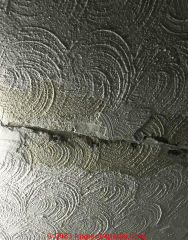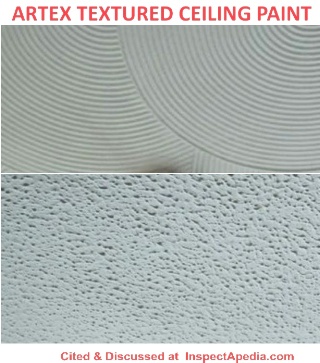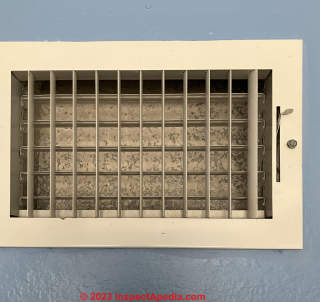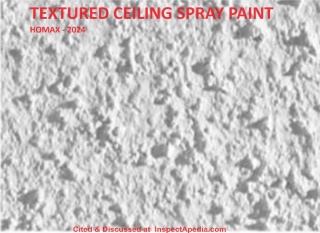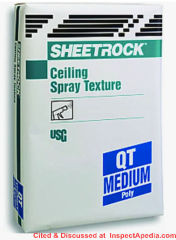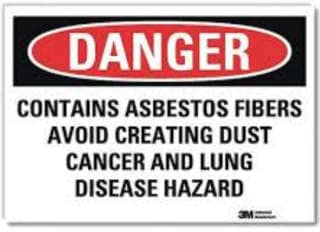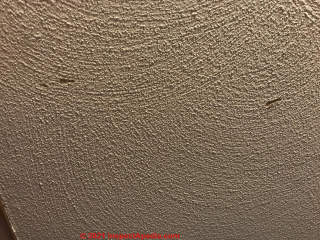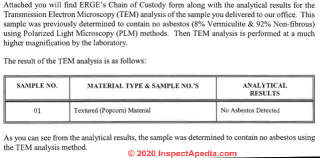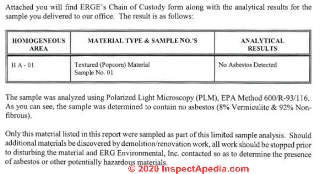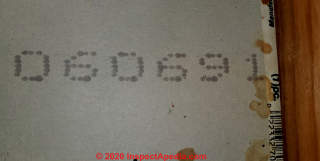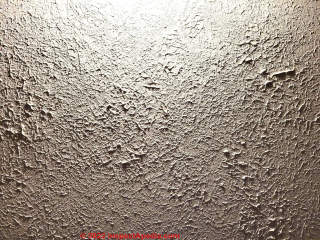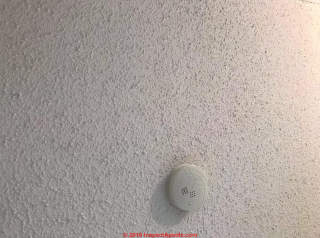 Asbestos hazards in popcorn & textured ceiling paints
Asbestos hazards in popcorn & textured ceiling paints
Recognize, remove, cover-up or handle asbestos-containing spray-on ceiling popcorn paint
- POST a QUESTION or COMMENT about how to identify popcorn ceiling paint that contains asbestos
Asbestos in Popcorn Ceiling Paint Sprays: how to recognize it, what to do about it.
Asbestos-containing ceiling paint: asbestos was used as a filler in popcorn ceiling paint - a nubbled or pebbled surface sprayed onto interior ceilings. This article describes how to recognize, test, and remove, cover, or renovate popcorn style ceiling paints that may contain asbestos.
Page top photo: popcorn ceiling spray paint coating, courtesy of InspectApedia reader Nathan.
This article series photographs and descriptive text of asbestos-containing products to permit identification of definite, probable, or possible asbestos materials in buildings. - Daniel Friedman
InspectAPedia tolerates no conflicts of interest. We have no relationship with advertisers, products, or services discussed at this website.
- Daniel Friedman, Publisher/Editor/Author - See WHO ARE WE?
Asbestos-containing "popcorn" or textured ceiling paint coatings
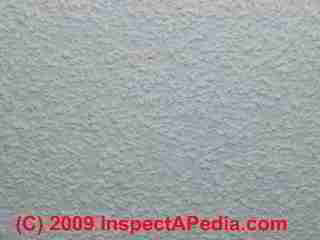 Asbestos Ceiling paints, textured or popcorn ceilings containing asbestos included spray-on acoustical ceilings and ceilings sprayed for fireproofing.
Asbestos Ceiling paints, textured or popcorn ceilings containing asbestos included spray-on acoustical ceilings and ceilings sprayed for fireproofing.
If renovation or ceilign demolition is planned it may be smart to simply handle this material as if it contained asbestos particles.
Or if you face a big cost then it's worth having a representative sample of the material tested for asbestos.
Photo above: popcorn ceiling paint on this older ceiling contained asbestos but also has been painted over causing it to look more smooth than when new.
[Click to enlarge any image]
Article Contents
- ASBESTOS-SUSPECT POPCORN CEILING COATING IDENTIFICATION
- ASBESTOS POPCORN CEILING REMEDIES
- VISUAL & OTHER CLUES to CEILING COATINGS PROBABLY NOT ASBESTOS
How to Recognize Asbestos suspect ceiling paint in popcorn ceilings
Some acoustic or decorative ceiling paint spray-on coatings contain asbestos that appears as a texture with thousands of tiny round protrusions or nubbles, close together.
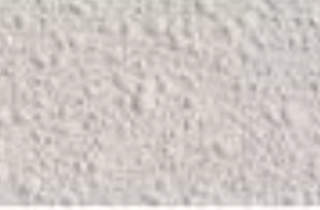
Each small protrusion or "nubble" ranges in size from 1/16 to about 31/6" in diameter, irregular in shape and never pefectly round. The paint was orignally sprayed using a special pneumatic textured paint sprayer that used an air compressor at 30-40 psi.
The spray gun could be adjusted to create the desired spray texture or pattern from a small "orange peel" to a medium "splatter" to a larger, more coarse pattern.
When we (DF) painted some building interiors (1970s - 198's) some clients asked for a popcorn textured ceiling with some flattened or smoothed areas, called a "knockdown" pattern. After the paint was sprayed the we used a 3" drywall knife to smooth down the highest protruding particles. We'll show an example of this knockdown pattern later in this article.
But for very small paint jobs or repairs, textured popcorn ceiling spray paints are also sold in aerosol spray can form.
Above is a very small pattern while below is a much larger particle spray from the same manufacturer.
The largest individual particle size in a popcorn or similar textured ceiling spray will vary depending on the product chosen.

If they've not been painted over with additional layers of normal ceiling paint, the individual protrusions or popcorns are fragile and soft - easily picked off with a fingernail.
Both popcorn pattern and other textured ceiling paints were particularly popular in North America in the 1970's.
Othered textured ceiling paint patterns like the swirled pattern shown below may also contain asbestos.
Popcorn ceiling paint, still used in a non-asbestos form, is sprayed onto ceilings and shows this very nubbly surface. In my opinion part of the popularity of popcorn and other textured ceiling paints is that it covers blemishes in the drywall installation job, allowing faster, less-costly construction and interior finishing.
If you are considering removing textured ceiling paint or "popcorn ceiling paint" in a building, since removing popcorn ceiling paint or textured paints that may contain asbestos are trickier than you may realize, here are some suggestions:
Watch out: During any construction, demolition, or building remodeling project, as dust and particles from many materials, even paper and wood can be irritating or harmful to workers and occupants, prudent procedure would include appropriate dust control, personal protection equipment, and cleaning methods.
Artex textured coating sold in the U.K.: Artex Ltd., produced Artex textured paint used on interior ceilings and sometimes walls, sold in the U.K. The company has been part of the French Saint-Gobain group since 2005.
Below: two examples of Artex asbestos-containing ceiling coating examples, adapted from UK HSE cited in our references section.
According to some sources Artex contained white asbestos until the mid 1980's.
Because that product containing asbestos may have been sold from old stock, homes built after 1985 but probably before 1990 and that used Artex textured ceiling paint in the U.K. may have asbestos-containing material in those locations.
...
Advice for Handling Asbestos-Suspect Textured Ceiling Paint
Photo: textured or popcorn ceiling paint overspray found inside the HVAC air supply register of a home.
We discuss possible asbestos hazards of this over-spray
at ASBESTOS POPCORN CEILING PAINT FOUND IN HVAC DUCTS
Here is our general advice for an older popcorn ceiling painted surface.
- Leave textured asbestos ceiling paint alone:
The best approach is to leave the textured ceiling paint material alone: experts advise that asbestos containing materials be left alone unless the material is damaged and bringing asbestos into occupied space.
In general people create more hazards by disturbing the material during a cleanup than if it were left alone. In sum the easiest, safest, least costly approach is to leave textured ceiling paint alone, in place. - Painting over a textured ceiling paint
coated surface, as long as the paint is secure, is what most people will advise. Try spray-painting as this will disturb sound in-place textured ceiling paint material least. - If you must remove textured asbestos ceiling paint,
that is, if there were a good reason to remove the paint, you'd probably to do it yourself (which requires specific procedures to protect health and to protect from contaminating the building) or more likely you'd need to use a professional asbestos abatement company.
The combination of health risk and risk of causing a still more costly dust contamination of the home are reasons to think twice before a do-it-yourself asbestos containing ceiling paint removal. - Do not hire someone unqualified
to remove the asbestos-containing textured ceiling paint nor any other asbestos-containing material. Use a licensed, qualified asbestos abatement professional. Even for collecting a sample of ceiling paint for testing, If the ceiling has already been painted, you would have difficulty wetting the material to do a scrape-off.
Watch out: Disturbing textured ceiling paint when it is dry is hazardous and should not be done even if the paint is not asbestos containing. - If you know the age of the building
you can infer whether or not there is likely to be asbestos at no lab cost whatsoever.
If your home was built in the 1980's or later asbestos ceiling paint is unlikely to be present.
Our photo, above, shows modern textured ceiling paint that does not contain asbestos. But you cannot determine this just by looking. Testing of a sample of the paint (wet to remove) is necessary. - For asbestos testing
and lead testing we recommend that you use either a local testing lab (look in your telephone book yellow pages under "Asbestos Testing" or "Asbestos Labs") or use a national,low cost high volume asbestos-testing-certified lab.
See ASBESTOS TESTING LAB LIST

- Asbestos-spray fireproofing is not the same as textured paints or asbestos-containing popcorn ceiling coatings
See ASBESTOS FIREPROOFING SPRAY-On Coatings for details.
At above left is a photograph of a spray-on fire resistant coating that was installed on a New York building in 2008. This coating will not contain asbestos, though it may resemble older asbestos-containing fire-retardant sprays.
...
Visual & Historic Clues Assist in Identifying Textured Paint or Popcorn Spray Paint Ceilings that Do Not Contain Asbestos
Above: popcorn ceiling spray paint, a current (2024) product, uses styrofoam, not asbestos to form its textured surface.
Modern popcorn ceiling paints are sold both in individual spray cans (Homax Ceiling Texture, illustrated above) suitable for spraying a small area, 2-liter containers for small jobs, and for commercial use, in larger quantity40 lb. dry-mix bags (USG Sheetrock QT Poly Medicum Ceiling Spray Texture, illustrated below).
Modern textured ceiling paints are sold in at least six different textures, as illustrated by the illustration below by Homax and found at Walmart and other stores. The finest texture is "light orange peel" and is only a bit larger in individual granules than sand paint ceiling treatments.
These non-asbestos products typcially use styrofoam or a similar plastic to form the textured beads or nubbles that are carried in a spray pigment to adhere to the surface.
While the following visual and historic clues are not necessarily conclusive, they give examples of reasons to infer that a textured ceiling spray - at least the coating that can be seen, touched, tested - does not contain asbestos.
- Building age: if your building was constructed after the last-use date for asbestos paint products in your country there's not much chance that a textured or popcorn ceiling contains asbestos
- Paint job age: if the spray paint on your building's ceiling (or less sensibly, walls) was itself applied after the last-use date for asbestos in your country, just as above, it's not likely to contain asbestos.
- Paint job containers, product labels, receipts, or similar documents can identify modern non-asbestos textured or popcorn ceiling sprays
Non-Asbestos Popcorn or Textured Ceiling Spray Product Examples
- USG Sheetrock Brand Ceiling Spray Texture SAFETY DATA SHEET [PDF] United States Gypsum Company, 550 West Adams Street Chicago, Illinois 60661-3637 Tele 800-874-4968 Website www.usg.com [illustrated above] - retrieved 2024/05/04, original source: https://ace.infotrac.net/getmsds.aspx?sku=1002922
- Homart,
The reader questions and our expert's replies below give examples of clues that help us determine whether or not textured or nubbly "popcorn" ceiling paint is likely to contain asbestos.
Is asbestos popcorn ceiling paint hard or soft?
Anthony said:
I have old plaster that has thin white brown fibers that are about as think as horse hair also i have popcorn paint on the side of the walls my question is.. is alspstose [sic - asbestos] popcorn celing paint soft or hard like cement, i was sanding the love out of it got me worried now. msg tonyboroni@hotmail.com cheers.
Moderator (df) Reply:
Anthony,
The asbestos-containing popcorn ceiling paint is rather soft, but might be harder if subsequently given additional coatings.
However the actual sperules that make the popcorn kernels in modern non-asbestos popcorn ceilings are typically made of still softer styrofoam that in my experience is easily brushed away from the building surface with almost no force whatsoever.
Is it possible to distinguish asbestos from non-asbestos popcorn ceiling paint by visual inspection?
Tyler said:
Is there a way to tell if a ceiling texture has asbestos by the pattern? Im checking out a potential job that has the very small pebble-like pattern to it and asbestos is a longer fiber. I noticed a lot of the articles about asbestos in popcorn ceilings seems to show a more spread out pattern.
Moderator Reply:
Tyler, in my opinion the size of the textured popcorn ceiling kernels is principally an artifact of how the mixture was prepared and how the spray gun was adjusted. Asbestos fibers themselves are microscopically so small that I'm doubtful that the choice of asbestos fiber type would determine the popcorn kernel size.
Also worth noting was the use of very fine asbestos filler as ultra fine particles in several building products including floor and ceiling coverings.
Popcorn spray on ceilings was popular in some parts of the world including North America from the 1950s, and contained white chrysotile asbestos through the 1980's.
Knowing that a ceiling was popcorn sprayed in the 1990's or more recently, or observing asbestos's successor material used to form the popcorn kernels or flakes, that is fine styrofoam pellets or flakes (Hanson 2013), in the ceiling popcorn kernels might help suggest which substances are present.
I find that modern styrofoam popcorn ceiling spray is a bit softer and more fragile than its antecedents, more fragile, easily brushed off of the surface by hand, and typically containing recognizable fragments of styrofoam in at least the larger popcorn spherules or kernels.
Watch out: even though the newer popcorn ceiling sprays won't contain asbestos, the spray might not contain recognizable asbestos particles.
We note that for repair of popcorn or similarly textured ceilings other fibrous materials (not styrofoam) are used and are applied using a method to cause them to clump together to resemble the styrofoam pellets used in initial application (Woods 2004), and consisting of
... Preferably, an example of the material 15 comprises a liquid base, a filler, an adhesive binder, a propellant, an anti-foaming agent, a suspension agent, and fibrous materials.
The liquid base may be any aqueous substance such as water and/or a non-aqueous substance such as alcohol, aromatic or aliphatic hydrocarbons, ketones, esters or the like.
The filler may be any material that can serve as an extender or bodifier such as limestone, clay, mica, silica, or similar materials, or a mixture thereof. The filler may also be made of a paint-based material.
The adhesive binder is an adhesive that may take the form of a natural polymer, such as gums and resins and the like, or a synthetic polymer, such as polyvinyl alcohol, polyvinyl acetate, acrylic polymers, alkyd resins, etc., or a combination thereof.If large expense or issues of making a mess arise then it's worth the small cost to test a sample.
See ASBESTOS TESTING LAB LIST
Question: is there an asbestos hazard in popcorn ceiling paint in a 1981 home?
We recently remodeled our 1981 home without much knowledge about hazards (yes, bad on us). It wasn't really something that we wanted to do but we had a disaster that necessitated.
The popcorn ceilings were sprayed with paint, inadvertently removing some of the popcorn and the old red ceramic (glazed white) jackhammered and replaced. The people working on the walls tested the drywall and paint for lead and asbestos.
Both were negative. We tested the tile with a home kit and it showed negative for lead.
We asked the guys who were jackhammering to use fans to blow dust out of the house, turn our AC off, and to put up a plastic barrier.
They did a decent, not perfect, job. They swept and wiped up. After all was said and done we swept and mopped up the remaining dust.
How worried for our toddler's safety should we be?
We didn't test the popcorn or the tile/grout for asbestos because we didn't know at the time. Are those an issue in 1981 homes? Would what was done to the ceiling (spraying new paint on accidentally knocking some popcorn off in the process) even be a problem? We will, of course, test if you recommend.
PS This was a few months ago we have been sweeping, mopping, and damp-cloth dusting since. I'm not sure how much original dust will be left. - Anonymous by private email 2016/09/16
Moderator Reply:
So let me get this right. You tested a number of things but not the popcorn ceiling. If that's the case and you want some peace of mind I suggest that you collect a representative sample of settled dust and have that analyzed by a certified asbestos test lab.
If the knock-off debris from your popcorn-painted ceilings was just a few specs I'd not be worried about an asbestos-contamination issue; if you needed to demolish the ceiling I'd either treat it as asbestos-containing or have a sample tested.
If you're un certain about the presence of a remaining hazard, find some settled dust from the work period and send it to a lab - see
I can almost always find old dust even in cleaned buildings. Look along high horizontal trim such as over doorways and windows, or on floors under radiators or baseboards.
…Although the 1978 Clean Air act in the U.S. led to cessation of manufacture of many asbestos-containing products, paint sellers and painters may have used "new old stock" into the 1980's so one cannot rule out asbestos-containing popcorn paint or textured paint in a home in the U.S. built or painted in the first half of the 1980's.
Reader follow-up: find out the age of your ceiling paint
2017/01/07 Update:
We have now learned that the ceiling in this building may have been painted or re-painted after the use of asbestos in ceiling paints had been discontinued. Therefore the recent remodeling may not have been the cause of uneven popcorn ceiling paint in this building.
Watch out: readers will want to take care not to panic about possible asbestos in popcorn ceiling paint before they have found the history and age of both their building and the paints used in and on it, including textured and popcorn-style ceiling paints. - Anonymous by private email 2017/1/07
...
Research & Patents for Popcorn Ceiling Paint Application, Removal, Asbestos Handling
- Faraci, Clifford C., Rustom A. Khan, and Daniel Winterstein. "Ceiling scraper vacuum accessory." U.S. Patent 6,601,266, issued August 5, 2003.
- Greer Jr, Lester R., Stephen E. Cunningham, and James A. Tryon. "Ceiling scraper with integral debris collector." U.S. Patent 6,101,663, issued August 15, 2000.
- Hanson, Randal W., Jinru Bian, John Kordosh, Jason Everett, and Jane D. Wasley. "Acoustic Ceiling Popcorn Texture Materials, Systems, and Methods." U.S. Patent Application 13/802,697, filed March 13, 2013.
Excerpt:
Acoustic or “popcorn” texture material is applied to interior surfaces of structures, and typically ceiling surfaces. Acoustic texture material comprises a base material and aggregate material in the form of visible chips or beads.
The aggregate material is adhered to the target surface by the base material. In new construction, the acoustic texture material is applied by a hopper gun, and the chips or beads are typically formed of polystyrene foam. The polystyrene foam chips act to dampen sound waves that would otherwise reflect off the target surface. - ASBESTOS, YOUR QUICK GUIDE [PDF], UK HSE, Health & Safety Executive, Web: https://www.hse.gov.uk/
describes Artex asbestos hazards in the UK. Retrieved 2018/04/05, original source: http://www.hse.gov.uk/asbestos/assets/docs/beware-asbestos-reference-cards.pdf
- Kubic, Thomas A. "Method for repairing a textured ceiling or overhead surface." U.S. Patent 5,474,804, issued December 12, 1995.
- LaVelle, Scot. "Method and apparatus for toxic substance encapsulation." U.S. Patent 8,721,818, issued May 13, 2014.
- Shumway, Christopher. "Scraper with debris collecting means and associated method." U.S. Patent 7,814,609, issued October 19, 2010.
- Stankowitz, James L. "Texture applicator." U.S. Patent 4,364,521, issued December 21, 1982.
- US EPA, EPA SHOULD UPDATE GUIDANCE TO ADDRESS THE RELEASE OF POTENTIALLY HARMFUL QUANTITIES OF ASBESTOS THAT CAN OCCUR UNDER EPA’S ASBESTOS DEMOLITION STANDARD REPORT NO. 15-P-0168 [PDF] (2015), retrieved 2019/02/09 original source: https://nepis.epa.gov/Exe/ZyPDF.cgi/P100RCY2.PDF?Dockey=P100RCY2.PDF
Excerpt: Chrysotile is a specific type of asbestos that had been used in numerous building materials produced by manufacturers of floor tile, roof shingles, wall and attic insulation, drywall joint compound, “popcorn” ceiling coatings, and Transite cement boards. - USG TEXOLITE PAINT PRODUCTS [PDF] Technical specifications, colors, textures, products, instructions, for US Gypsum's Texolite paint, from 1952
- Viviano, James C. "Vacuum acoustic ceiling removal system." U.S. Patent 8,108,966, issued February 7, 2012.
- Woods, John R. "Hardenable flowable substance stored in fluid state and is dispensable in the form of an aerosol spray from a fluid-tight container, after being released and curing, forms bumpy, irregular surface texture, matches with surrounding." U.S. Patent 6,797,051, issued September 28, 2004.
Excerpt:
U.S. Pat. Nos. 5,505,344, 5,476,879, and 5,341,970, all to the present Applicant, disclose an acoustic ceiling patch that is sprayable from a hand-held aerosol dispenser. However, certain materials, such as Styrofoam (Dow Chemical Company, Midland, Mich.), used in the acoustic ceiling patch to provide texture in the material, cannot be used in the presence of volatile organic compound (VOC) propellants because they will deteriorate or melt.
Therefore, only non-VOC propellants or compressed air may be used with these materials. However, the use of non-VOC propellants or compressed air require a greater pressure to dispense the patch containing these materials.
The greater pressure may lead to some loss of control for the user when spraying the patch material. Along with the use of a greater pressure to dispense the patch material is the decrease in atomization of the patch material when being dispensed.
...
It has been discovered that the use of fibrous materials allows the patch material to clump together to form particulates resembling the Styrofoam used in conventional methods. This helps produce the “Popcorn effect”.
The patch material can then build up upon itself without a need for additional repair material on the damaged area.
An object of an embodiment the present invention is to provide an acoustic ceiling spray patch material that is storable and dispensable from a hand-held dispensing unit for spray-on and direct application of the material in a liquid or semi-liquid form onto a repaired or patched area so that the surrounding surface texture will be visually and mechanically matched.
Another object of an embodiment of the present invention is to provide an inexpensive, practical and economical means for matching the surface texture of a repaired or patched surface area on an acoustic ceiling with the surrounding acoustic surface texture.
...
The hardenable flowable material includes a base, a filler, an adhesive binder, fibrous materials, that do not decompose in the presence of VOC propellants in the preferred embodiment of the present invention, an anti-foaming agent, a suspension agent, and an aerosol propellant, preferably a VOC propellant, that serves as a carrier medium and a pressure source ... - Woods, John R. "Acoustic ceiling patch spray." U.S. Patent 5,505,344, issued April 9, 1996.
Excerpt:
An acoustic ceiling surface usually presents a surface texture which is bumpy or presents an orange peel look and sometimes is referred to as a "Popcorn effect". - [9] Lipsitz & Ponterio, LLC, "Carpenters and Mesothelioma", Lipsitz & Ponterio, LLC, 135 Delaware Ave, 5th Floor, Buffalo, NY 14202-2415 (716) 849-0701. Web search 6/22/12, original source: http://www.mesotheliomacarpenter.com/carpenters-asbestos-exposure/ceiling-tile/ [Copy on file as LiIpsitz_Asbestos.pdf]
- [16] Steven Mlynarek, Morton Corn, Charles Blake, "Asbestos Exposure of Building Maintenance Personnel", Regulatory Toxicology and Pharmacology, 23, 213–224 (1996) ARTICLE NO. 0045, http://library.certh.gr/libfiles/PDF/GEN-PAPYR-4810-ASBESTOS-by-MLYNAREK
-in-RTAP-VOL-23-ISS-3-PP-213-224-Y-1996.pdf - [17] National Institute of Occupational Safety and Health (NIOSH) (1989). In NIOSH Manual of Analytical Methods (P. M. Eller, Ed.), Method 7400. NIOSH, Washington, DC.
- [18] U.S. Environmental Protection Agency (USEPA—Green Book) (1990). In Managing Asbestos in Place: A Building Owners Guide to Operations and Maintenance Programs for Asbestos-Containing
- [19] U.S. Department of Labor, Occupational Safety and Health Administration (USDOL) (1994). In Occupational Exposure to Asbestos: Final Rule, FR Vol. 59, No. 153:40964–41162. Materials, Report 2OT-2003. USEPA, Washington, DC.
- [20] U.S. Department of Labor, Occupational Safety and Health Administration
(USDOL) (1986). In Occupational Exposure to Asbestos: Tremolite, Anthophyllite, and Actinolite: Final Rule, FR Vol. 51, No. 119:22631–22644. - [21] U.S. Environmental Protection Agency (USEPA) (1990). In Environmental Asbestos Assessment Manual, Superfund Method for the Determination of Asbestos in Ambient Air, Part 2, Technical Background Document, Report EPA/540/2-90/005 b. USEPA, Washington, DC
- [26] "Directive 2003/18/EC of the European Parliament and of the Council of 27 March 2003 amending Council Directive 83/477/EEC on the protection of workers from the risks related to exposure to asbestos at work". Publications Office of the European Union. 27 March 2003 Web search 6/30/12, original source: http://eur-lex.europa.eu/LexUriServ/LexUriServ.do?uri=CELEX:32003L0018:EN:NOT,
- [27] H. M. Murray, testimony before the Departmental Committee on Compensation for Industrial Diseases "Minutes of Evidence, Appendices and Index", 1907. p. 127
- [28] D. Auribault, "Note sur l'Hygiène et la Sécurité des Ouvriers dans les Filatures et Tissages d'Amianté (On hygiene and security of the workers in the spinning and weaving of asbestos)" in Le Bulletin de l'Inspection du Travail, 1906, pp 120–132.
- Asbestos Identification and Testing References
- Asbestos Identification, Walter C.McCrone, McCrone Research Institute, Chicago, IL.1987 ISBN 0-904962-11-3. Dr. McCrone literally "wrote the book" on asbestos identification procedures which formed the basis for current work by asbestos identification laboratories.
- Stanton, .F., et al., National Bureau of Standards Special Publication 506: 143-151
- Pott, F., Staub-Reinhalf Luft 38, 486-490 (1978) cited by McCrone
- Asbestos NESHAP ADEQUATELY WET ASBESTOS GUIDANCE, EPA340/1-90-019, December 1990, U.S. ENVIRONMENTAL PROTECTION AGENCY, Office of Air Quality Planning and Standards, Stationary Source Compliance Division, Washington, DC 20460,original web source: http://www.epa.gov/region04/air/asbestos/awet.htm
- EPA ASBESTOS MATERIALS BAN: CLARIFICATION 1999
- "Handling Asbestos-Containing roofing material - an update", Carl Good, NRCA Associate Executive Director, Professional Roofing, February 1992, p. 38-43
- EPA Guidance for Controlling Asbestos-Containing Materials in buildings, NIAST, National Institute on Abatement Sciences & Technology, [republishing EPA public documents] 1985 ed., Exposure Evaluation Division, Office of Toxic Substances, Office of Pesticides and Toxic Substances, U.S. Environmental Protection Agency, Washington,D.C. 20460
...
Reader Comments, Questions & Answers About The Article Above
Below you will find questions and answers previously posted on this page at its page bottom reader comment box.
Reader Q&A - also see RECOMMENDED ARTICLES & FAQs
Can we Skim Coat our 3% Asberstos Popcorn Ceiling? WITHOUT sanding?
Our home in California was built in 1962.
We have hired an abatement company to remove our asbestos popcorn ceiling (3% asbestos). The mud in the ceiling is 2% asbestos.
We are very concerned about asbestos. We will repaint the ceiling and walls after abatement.
Problem: Very expensive to have popcorn ceiling removed and still have asbestos in the mud. We don’t want to sand the ceiling mud, as it makes no sense (to us) to release asbestos after the popcorn is removed.
Question: Can a skim coat be put on WITHOUT sanding? Do you have any suggestions to remedy our dilemma?
Thanks for your attention and time, and I do hope to hear from you at your earliest convenience. - On 2022-09-05
by Anonymous by private email -
On 2022-09-06 by InspectApedia-911 (mod) - Don't sand popcorn ceiling paint; better to cover-over.
@Anonymous by private email,
Watch out: first, it's not appropriate to sand an asbestos-suspect popcorn or textured ceiling. That creates a huge amount of dust that could be quite dangerous and quite costly to clean-up. That's not a recommended procedure. It is possible to remove some textured paint coatings by judicious wetting, dust control, proper cleanup.Alternatively, you could skim coat the entire ceiling with joint compound but in my opinion that's a high-labor, low reliability effort.
If it were my home I would certainly not just remove the popcorn ceiling paint - it would be less expensive to simply remove the ceiling drywall completely and install new drywall.
The containment steps are the same and the labor to tear down a ceiling and replace it is in my OPINION less work than wetting and scraping off and re-finishing the original popcorn painted ceiling,
adding the advantage of getting rid of all of the material that concerns you.
There might be a slightly higher cost to dispose of the greater volume of construction debris but considering that once the old ceiling has been removed and the space properly cleaned, the work to put up a new drywall ceiling is ordinary construction and doesn't have to be done by an expensive asbestos abatement company.
Alternatively you could have left the ceiling completely alone, intact, and simply laminated over it with a thin layer of new drywall, perhaps using 1/4".
On 2022-08-19 by Hannah - I really appreciate all the expertise on this website and how much you help people. Now: shoudl I test my water-damaged sand-textured ceiling for asbestos?
Hello! I really appreciate all the expertise on this website and how much you help people. I moved into a new apartment a few months ago and recently discovered a little bit of water damage in the ceiling, which is textured. I don’t think that it’s popcorn, I believe it’s some kind of sand texture, and it has visible brush strokes.
The damage itself is on a pretty small area, probably no more than 6 square inches, in a fairly inaccessible area of the kitchen ceiling above the cabinets. It’s pretty clear to me that this is old damage — the leak has definitely been resolved, but the ceiling and some damage to the wall under it wasn’t fixed afterward. All the apartments in my building were renovated in 2005, and the same ceiling paint is present throughout all the apartments as well as in the main common areas.
My question is — do you have advice on whether to test it or not? I realize that water damage is an issue on its own, but my landlord has been reluctant to make other repairs and I expect we’ll just have to live with it if there’s no asbestos involved.
Given that it seems like a reasonable chance (but not a guarantee) that the ceilings were done in the last 20 years, and that the damaged area is small, out of the way, and not continuing to deteriorate, I’m having trouble deciding whether it’s worth disturbing it to try to get a sample (as safely as possible) or better to just leave it alone.
I’m not at home currently, but can provide pictures later if they would be helpful! I know you probably can’t say much without seeing it and would probably want to err on the side of caution — but I would appreciate any insight or advice you can provide.
Reply by InspectApedia-911 (mod)
@Hannah,
Key to answering the question of "Should I test the "sandy" textured ceiling for asbestos" turns on the building location (country and city) and building age.
If your apartment is in the U.S. and was built after 1986 there'd be little justification for testing the ceiling for asbestos.
When you say ceilings were "done" in the last 20 years - that's after 2002 - nobody in the U.S. (if that's where you are) would be using asbestos drywall or ceiling paints at that time.
In general, asbestos containing material is safe and legal to leave alone and in place as long as the material is intact and not disturbed.
So if you were going to tear down a ceiling or conduct some similar dust-creating demolition and if your building is in the U.S. and older than 1986, you'd either treat the drywall in general and a textured painted ceiling as well as presumed to contain asbestos.
On 2022-08-19 by Hannah
@InspectApedia-911,
Thank you for your answer! I definitely did leave some info out of my initial message. This is in the Boston area in the US. The building itself was built in the early 1900s (records I’ve found say 1900-1920). I do know that it had quite a bit of renovation done around 2005 (which is when I believe the ceilings were painted).
I’m trying to get more information from city permits about what renovations where done and when, but it seems like there’s at least some reason to believe that a lot of the building materials were installed more recently than the 80s. (unfortunately my landlord also did some repairs to the drywall that were pretty dusty without a ton of containment, so I’m working on figuring out if we need more intensive cleanup as well, hence digging into permits.)
I guess my question is — while I believe the ceiling was painted after the end of asbestos ceiling paint use, I can’t say for 100% sure, and I’m not sure if some bubbled paint counts as “intact and not disturbed.” If you can offer any insight, I would appreciate it, and I understand if you don’t have enough information to go on based on my message!
Reply by InspectApedia-911 (mod) - if the paint is remaining in place it's not a hazard
@Hannah,
If the paint is remaining in place it's not a hazard.With regard to the 'little bit of water damage' you mention- if there was a leak, someone should have followed the water, seen what got wet, and gone to at least the 1 or 2 most-suspect areas in walls, ceilings, etc. to check for hidden mold or other damage.
Which Manufacturers used Asbgestos on the Finish Coat of Ceiling Tiles / Panels?
What manufacturers had asbestos in the finish coating of ceiling tiles and panels? On 2022-05-04
by John parker
Reply by Inspectapedia Com Moderator (mod)
@John parker,
see
CEILING TILE IDENTIFICATION
and also to be sure see
CEILING TILES ASBESTOS FREE
On 2022-05-05 by John parker
@Inspectapedia Com Moderator, ok im talking about the coatings only of the tiles containing asbestos, is there a link with manufacturers that put asbestos for coating only?
No I haven't found actual evidence myself but as I just started remodeling homes and have called around and talked to several different asbestos abatement companies and my one question impaticular was does the fiberboard ceilings from around 50s have asbestos and the answer they all gave me was not normally in fiberboard itself but in that era depending on the manufacturer some ceiling tiles/ panels have tested positive in the finish coating only.i called several all in the United states also.thanks
On 2022-05-07 by Inspectapedia Com Moderator (mod) - ceiling tile manufacturer would make all parts of product
@John parker,
It's correct that fiberboard, as generally used, refers to a plant based or wood-fiber based board product used for sheathing or insulation.
Thanks for the clarification.
In sum, I don't think you can find a company whose product was an asbestos-based coating that was used by ceiling tile manufacturers to coat their ceiling tiles as part of the production process.
Rather the same company that produces a ceiling tile produced its components and applied them together.
There were, of course, textured paint products that anybody might have later applied to a ceiling or wall, some of which contain asbestos, as you should read in the page above.Thank you for clarifying the question. It's an interesting one that I have not considered.
Have you found any evidence that there were such manufacturers? If you can give me a starting point I'll be glad to put our team on researching in greater depth.
On 2022-05-08 by John parker - I found a U.S. Patent that I think describes asbestos coatings on other non-asbestos material
@Inspectapedia Com Moderator, so what if people down the years painted the ceilings in regular paints and not textured paint.would the regular paint have contained asbestos?
For example I found this US2813046a patent
Could this perhaps be one source they could be talking about for asbestos coatings on non asbestos material
On 2022-05-29 by InspectApedia-911 (mod) - asbestine is a different mineral than asbestos, with some similar properties
@john parker,
In concept, yes there were fire retardant coatings used or proposed for use as a coating for some fiberboard products.
The patent you cite did not use nor contain asbestos.You'll see that asbestine is fibrous magnesium silicate. Asbestine, aka linum vivium, is also fire resistant, but it's not asbestos. Currerntly asbestine is used in some products such as paper goods and it has been used in cast stone products.
See the discussion of asbestine in
- Roberts, Matt T., and Don Etherington. Bookbinding and the Conservation of Books. A Dictionary of Descriptive Terminology. Superintendent of Documents, US Government Printing Office, Washington, DC 20402 (LC 1.2: B64/3)., 1982.
On 2022-05-29 by john parker
@InspectApedia-911, im sorry i saw asbestine,is it not asbestos?
On 2022-05-29 by InspectApedia-911 (mod) - differences between asbestos and asbestine
@john parker,
Please see what else you can find by some research. Do report back what you read.
Was asbestos used in other paints besides texture or popcorn?
ok was asbestos in interior paints for ceilings or walls other than texture or popcorn.i mean like cans of spray paints,smoothe flat paints just regular paints?
would it look smooth though or be bumpy like a popcorn or texture if it had asbestos in the paint? On 2022-04-19 by susan richards
Reply by Inspectapedia Com Moderator (mod) - Fire retardant paint might well be smooth in surface texture
@susan richards,
Yes , for example asbestos was used in some fire-retardant paints. Fire retardant paint might well be smooth surfaced rather than textured or "popcorn" .
Troweled-on ceiling textures may also contain asbestos?
In rare instances, private homes may have asbestos material sprayed or troweled on walls or ceilings,although this is much more likely to be found in large offices or apartment buildings built before 1973.
I found this on the epa journal and im wondering if this means that popcorn or textured ceilings or walls in home are not common to have asbestos in them or is this referring to some other kind of material? - On 2022-01-11
by jimmy armstrong
Reply by Inspectapedia Com Moderator
@jimmy armstrong,
Yes, "sprayed-on" ceiling paints could include "popcorn ceilings" that at one time used asbestos or asbestos-containing vermiculite.
And Troweled-on textured surfaces on walls or ceilings also could have used asbestos.
Follow-up by jimmy armstrong
what i mean is this says its rare to find the asbestos in the home on sprayed or troweled on material. so does that mean that asbestos in popcorn or textures is not common to be found in the home? On 2022-01-12
Reply by Inspectapedia Com Moderator - asbestos found in spray-on or trowel-on products
@jimmy armstrong,
No. Such coatings were not rare
And spray on and travel on products were very widely used in Residential Properties for a number of years.
My popcorn ceiling paint test came back negative for asbestos but contains vermiculite. Is this really safe?
Hi guys!
I live in a 1975 home in Minnesota. I have tested 8 samples of the popcorn ceilings from 8 different rooms. All 8 came back negative for asbestos. We used three different NVLAP labs (western, emsl, and San-air). 3 of the samples were taken by a certified inspector. The rest taken by us.
All ceilings appear to have been applied at the same time (subjective, but inspector agreed). 2 samples came back as 95% non-fibrous and 5 % mica. 3 samples came back as all non-fibrous. 3 came back as 5% vermiculite, 95% non-fibrous.
We’ve recently had all of the ceilings flattened. There was some mess (expected) that we cleaned up thoroughly. I’ve also been stupid in the past and dry scraped some of the ceilings upstairs. I obviously won’t do that again.
What gives me pause is the inconsistent results with the fillers (mica? Vermiculite?) and potential for asbestos contamination with vermiculite. I know what’s done is done, but how confident can I be about these ceilings and their negative asbestos content?
Thanks in advance! On 2022-01-01
by Kate
On 2022-01-01 by Inspectapedia Com Moderator - if the ceiling paint samples were representative
@Kate,
Thank you for a helpful question about the asbestos content in textured or popcorn ceilings. I'm getting puzzled by exactly the same thing as you, that is in mica or vermiculite content of the ceiling paints.
Both of those products might contain asbestos. However not all mica nor vermiculite do contain asbestos. The risk depends largely on where those products were mined.
One would expect a qualified NVLAP laboratory to be competent and to use proper procedures when specifically asked to test a material for asbestos. Those procedures are themselves defined by US Government standards.I acknowledge that ultimately it's the accuracy of the sample collection by someone you hired and then the procedures used and care taken by the actual lab technician who is conducting the test that determines the true accuracy of the result. But the combination of training, accreditation, and supervision responsibility of the lab is the best anyone can expect to rely upon, and using three different labs is as careful as one could imagine being.
I'd have been more concerned if you sent the same test sample material to different labs and got different results.
For other readers who are not familiar with NVLAP accreditation:
AMENDMENT OF 15 CFR 285
A final rule amending 15 CFR Part 285 National Voluntary Laboratory Accreditation Program (NVLAP) was published on September 24, 2020.Title 15, part 285 of the Code of Federal Regulations was first published on February 25, 1976 to establish the procedures and general requirements under which NVLAP operates as an unbiased third party to accredit both testing and calibration laboratories and has been revised several times.
This amendment incorporates revisions necessary to operate in accordance with ISO/IEC 17011:2017, Conformity assessment –
Requirements for accreditation bodies accrediting conformity assessment bodies and ISO/IEC 17025:2017, General requirements for the competence of testing and calibration laboratories.
Further, these revisions include recognition of proficiency testing as an accreditation activity, addition and/or revision of terms, and update of the NVLAP mailing information. - retrieved 2022/01/01, original source: NIST www.nist.gov/nvlap
For questions or additional information, please contact NVLAP at nvlap@nist.gov.
On 2022-01-10 by Kate - So I don't need to worry at all about asbestos, right?
@Inspectapedia Com Moderator, @Inspectapedia Com Moderator,
So can I rest assured that these ceilings are probably negative?
Thank you.
Reply by Inspectapedia Com Moderator - Asbestos content in textured or popcorn ceilings
@Kate,
Well gee: you've paid for eight asbestos test samples by multiple collections, collectors, and test labs and you've got those results.
Forgive me as we really do want to be helpful, but I'm unclear on how a text-based consult with a website tech support team can be more-reliable than your certified asbestos test labs.
It's fair to consider that the samples collected and tested have to be representative of the material in question - not something we can assess from here.
Is it safe for me to remove popcorn ceililng paint that is made of styrofoam?
i took a sample of my popcorn ceiling and its made of styrofoam. The house was built in 1999. Do you think im completely in the clear to remove it myself without getting it tested or is there still a chance my ceilings have asbestos? - On 2021-09-10
by robyn
Reply by Inspectapedia Com Moderator: yes
@robyn,
I'm sure you will appreciate that nobody with any experience at any sense of going to bet your life, money, health, safety on a brief e-text about a building for which I know close to nothing.
However it's reasonable to say that it would be rather unusual to find popcorn ceiling that used styrofoam and that also contained asbestos.
The date of your building, if it's in North America, places it after the time that asbestos was used in such materials and of course you understand that styrofoam it's not only not asbestos, it marks the material as from the post asbestos epoch.
On what types of surfaces was popcorn ceiling paint sprayed?
what type of ceiling material was popcorn textures used on? could it be used on the old plywood and fiberboard type? - On 2021-09-01
by rose williams
On 2021-09-01 by Inspectapedia Com Moderator
@rose williams,
Popcorn ceiling paint, popular in some countries like the U.S. in the 1970s, was usually sprayed onto drywall, but of course someone could have sprayed that paint product on other surfaces including plywood, paneling, even ceiling tiles.
Are we in deep trouble because our 1969 house might contain asbestos ceiling paint?
Hi. My wife and I (we have 1 dog and no kids) bought our house in March, 2018. It was build in 1969. We have been thinking about remodeling the downstairs and we have textured ceilings in almost every room both downstairs and upstairs (except for bathrooms, closets, and utility room). It has very recently occurred to me that my ceilings may contain asbestos paint (nobody, including home inspector mentioned it as a possibility before).
Since we moved in, we have had some remodeling done on the ceilings, including installing a few light fixtures, new smoke detectors, a ceiling fan, and an AC duct. In the past few months, I also removed some ceiling mounted blinds, old smoke detectors, and their drywall anchors (scraped some of the pain too, oops).
I am fairly certain that my shingles and the 9"x9" floor tiles in my downstairs do contain asbestos, which makes me afraid that the textured ceiling paint might contain asbestos too. (I dunno if it matters, but I think I can see fan-shaped brush strokes in the ceiling paint, so maybe it was brushed on?)
I think that both upstairs and downstairs ceilings have been painted over at least once. Most of the ceilings are in good condition, however, there are some areas where the is a little chipping (one photo is included) on the ceiling, the door to the attic, at a drywall joint on the beam downstairs, and some exposed areas where I removed the drywall anchors/ mounting hardware. I can send other photos if you wish.
I tend to get pretty alarmed about things like this and would like a little advice as I am not really sure what to do...except panic. If I have already contaminated my airspace, I guess I am already screwed (at least health wise).
If I call an inspector to have the paint tested and it contains asbestos, I could be in for a hefty abatement (my home is 2,200 sqft). We bought the house thinking that we would stay here for 30 years, but with this and other issues (like all the updates we need) we are having second thoughts.
However, selling seems more difficult as nobody is going to want to buy the house if they know that the ceilings have asbestos, and I would feel bad about keeping it a secret (if I knew the paint contained asbestos of course; I suppose the situation might be slightly different if I do not have anything tested and decide to sell soon).
The only good news I have is that a coworker checked my whole house with an XRF gun and found no lead paint. Yay!
Again, any advice would be appreciated. Hopefully I am not completely screwed.
-Peter On 2020-01-26
Reply by Inspectapedia Com Moderator - DF
Peter
My reply is based on several decades of inspecting and testing buildings for asbrestos contamination and advising clilents on handling asbestos hazards.First-off, panic is the first thing to avoid as it is bad for your health, probably worse than any asbestos-containing ceilings, and as it also means that anybody you talk with is going to charge double as a "fear premium".
The sand-textured paint in your photo is not the same as a "popcorn ceiling" coating. The latter has blobs that are bigger and softer than sand granules.
Asbestos "paint" would be uncommon in a home on ceilings or walls; Asbestos may be in drywall or joint compound. It's not radioactive; Just left alone, intact it's safe and legal to leave asbestos-containing materials in buildings.
What you do want to avoid is a dusty demolition.
Does an asbestos test of left-over dust from a popcorn ceiling removal assure me it didn't contain asbestos?
I recently bought a house built in 1953. I had the popcorn ceiling removed by a second party and unfortunately did not have it tested. The ceiling was then covered with drywall mud and sanded.
I freaked out a bit after researching more on asbestos and ended up getting some of the dust left from the sanding tested. It came back negative for asbestos.
Is it safe to say that from those results that the popcorn ceiling did not contain asbestos? - On 2019-01-03 by Chris -
Reply by Inspectapedia Com Moderator
Chris I can't do better than your certified asbestos test lab who processed your sample.
In any environmental sampling plan the choice of sample material and how it is collected are critical - if you think the sample is representative of your indoor conditions, that's what you want.
Was my popcorn ceiling asbestos test adequate? Example Asbestos Test Reports
[paraphrasing] Here is my asbestos test lab report on samples collected from the popcorn / textured ceiling of a home in Alabama.
I took samples from three separate areas into one bag in a 500 sq ft area . I've spoken with a few companies and this was the ceiling asbestos test procedrue that they recommended.
The ceiling paint sample was collected by scraping three 2x2-inch areas.
I followed your procedure for dating my ceiling drywall and belive it was manufactured on 06/06/1991. With that being said that vermiculite would be from that time period so on the fringe I guess you would say .
Can you add anything to the test report given below? - Anonymous by private email 2020/09/16
- POPCORN CEILING ASBESTOS TEST REPORT - TEM [PDF] ERG Environmental, Inc., 11 Sept. 2020
- POPCORN CEILING ASBESTOS TEST REPORT - PLM [PDF] ERG Environmental, Inc., 11 Sept. 2020
Moderator reply:
Thank you for the question and asbestos test lab report for your popcorn ceiling, Anon.
Both your TEM and PLM lab rests found no asbestos in the popcorn ceiling paint.
I note that the TEM asbestos test lab report states that 8% vermiculite was found in your popcorn ceiling.
It's also usually possible to identify vermiculite by careful visual inspection or by forensic microscopy;
So my observations include the following:
1. Assuming that your sample collected the texture-imparting material in the ceiling paint of of a U.S. home in Alabama there does not appear to be any asbestos hazard in the textured paint coating itself
2. The manufacture date of the gypsum board used to form the ceiling reported as in 1991 makes it unlikely that the gypsum board itself contains asbestos
3. No test was reported of the joint compound that's normally used at drywall ceiling joints and that often is a more-serious asbestos hazard source, but as the earliest likely date of the ceiling's installation has to follow the manufacture date of the ceiling drywall it's not likely that the joint compound contained asbestos - unless someone made use of old stock from before 1989
4. The following quote from the US EPA is excerpted from https://www.epa.gov/asbestos/epa-actions-protect-public-exposure-asbestos
EPA Actions to Protect the Public from Exposure to Asbestos
One of EPA’s priorities is to protect the public from adverse health effects of asbestos. Actions to protect the public from exposure to asbestos under the Toxic Substances Control Act (TSCA) include the following three pieces. ...
1989 Partial Ban on the manufacture, import, processing, and distribution of some asbestos-containing products. EPA also banned new uses of asbestos which prevent new asbestos products from entering the marketplace after August 25, 1989. These uses remain banned. The April 2019 final rule does not provide a way for these uses to return to the marketplace.
Reader follow-up: 8 % vermiculite detected in popcorn ceiling paint
Thank you for your response and effort for doing this it is very helpful . Please do [post this information as] my hope is that it would help someone else as well.
I sent the PLM report as well it states that it is 8 % vermiculite.
Moderator reply:
It will help others. thank you for the discussion; working together helps us both. Stay safe and COVID-free
Reader Follow-up: how I dated the year of manufacture of ceiling drywall
This is how I dated my sheetrock ceilings. Finally got a chance to go back in the attic . - 2020/10/10
Moderator reply:
Thanks Anon - that looks like a June 1991 drywall manufacture date code, I agree.
Does this 1986 painted on rough-textured ceiling contain asbestos?
I will most likely get this tested at some point, just haven't had a chance yet, but just to get a rough idea of the possibility of it containing asbestos, as I always hear the sprayed had it, but not sure about the painted on/sponged variants,
this textured ceiling was done and finished in about March of 1986 as part of the addition to the home, it was not sprayed on, it was painted on from what I was told, was able to talk to the wife of the man who built the addition,
she doesn't think that it does have asbestos, and she was here everyday with them when they were doing it, but that was about 36 years ago, they did the entire addition with this texture ceiling, and then re-did the laundry room of the original house with the same ceiling type. - On 2022-07-12 by Will
Reply by InspectApedia-911 (mod) - possibly
@Will,
A textured paint installed so near end of the use of asbestos in textured ceilings could have been old-stock manufactured earlier and so could contain asbestos.
The paints that typically contained asbestos were sprayed-on popcorn ceiling paint, and also some of the thicker rolled-on textured surfaces that were applied with a long nap roller.
Your product looks like something else.
On 2022-07-12 by Will
@InspectApedia-911, from what I was told, they put up sheetrock or something of that nature and used paint with brooms or mops to get the texture, and by this point at that time my grandparents had already been working for the state running a group home for awhile, and the addition was for extra rooms at the time, so I'd imagine there would have been rules against using asbestos just based on that alone.
It was interesting enough that I thought I'd throw the question out and see what it looked like to you, I've seen many different pictures of textured ceilings, but nothing like this one, maybe they used latex paint and splattered it, and just let it drip until it dried, but I'm not sure, probably not asbestos, but getting it tested at some point , should be interesting to see what exactly they used.
On 2022-07-13 by InspectApedia-911 (mod)
@Will,
Thank you for the added details I agree that the texture doesn't look like anything familiar.
It would be generous of you and would allow us to be more helpful if you would provide as much information as you can when you're asking us for help or advice.
On 2022-07-13 by Will
@InspectApedia-911, my wording my have been incorrect in that I meant it was an interesting texture to me, but I did not know anything about what it could be nor do I know what it is now,
that was why I added a photo and gave as much information as I could at the time to see if anyone had any possible theories on what it might be, and it just being paint and splattered on is a complete guess on my part, I've no idea what it is, was done before my time and the man who did it has been gone for years, so I had no idea if this was a ceiling type that would contain asbestos or some generic item.
My apologies for the wording, but it was by no means meant to be a test or trick question, the question was legitimate with legitimate concern about what it is or if it might be asbestos, the other information I only aquired after managing to find out the builders wife was still alive, and that was her best guess of any extra information.
On 2022-07-13 by InspectApedia-911 (mod)
@Anonymous,
Thank you so much.
We must both remember how easy it is to misunderstand when all we have is text messages.
I agree that the ceiling looks like a homemade hodgepodge of stuff stuck in to paint.
On 2022-07-13 by Will
@InspectApedia-911, This is very true, and my apologies for the miscommunication on my part, I'd meant to relay it as I'd managed to get some of the story from the wife of the man who built the add-on after I'd asked the initial advice, but it was no means anything of certainty.
Once I get it it tested I will happily share the report, just in case anyone else ever comes across something of this nature, I think in a way it's not scary, but maybe a slight bit of concern when there's no clue what it actually is.
It's definitely had me a bit concerned when I really paid attention to it and saw that textured ceilings, etc., had asbestos into the 90s with old stock, I'd never seen anything like this, so I wasn't and still am not quite sure what it is, and I would not be surprised if someone else out there might come across something similiar from the 80s.
I definitely appreciate the advice and thoughts on it, helps very much to alleviate some of the concern, hopefully the lab test will give us a good idea of what this is for certain. And again my apologies on the miscommunication on my part that made it come off as a trick or test instead of a legitimate question/concern.
Reply by InspectApedia-911 (mod) - laminate a thin layer of quarter inch drywall
@Will,
Thank you for the courteous discussion.
Yes, if you do asbestos testing and post those results here that will help other readers.
Whenever I've had to address a textured ceiling that was no longer wanted or was in poor condition, as long as it hadn't been wet and become moldy, I've considered as an option to removal, simply laminating a thin layer of quarter inch drywall over the whole ceiling.
On 2022-08-21 by Will
@InspectApedia-911, Not a problem, very easy to misunderstand in text, and best discourse is a calm discussion to understand the context. I haven't had it tested just yet, but I did have to replace a smoke detector. When I took it down, the inner section was fully white, akin to drywall; obviously, I need to have it tested to confirm.
Still, it looks like what I have run into in this section was most likely drywall that was painted to get that pattern; I've noticed that it looks like brush strokes in some areas. And being it was 1986 when that ceiling was done probably was less likely they used to spray with asbestos in it, and being a residential home most likely lessens the odds since the tile that I linked in another forum turned out to be cellulose.
I just wanted to add a bit more information here, I didn't get the chance to grab a picture, but it definitely looks like the white in between standard drywall. Still, once I get a chance to have it thoroughly tested, I will post back the findings here in case anyone ever runs into a ceiling like this.
...
Continue reading at ASBESTOS POPCORN CEILING PAINT FOUND IN HVAC DUCTS or select a topic from the closely-related articles below, or see the complete ARTICLE INDEX.
Or see CEILING PAINT TEXTURED ASBESTOS FAQs - questions & answers posted originally on this page
Or see these
Recommended Articles
- ASBESTOS CEILING TILE IDENTIFICATION - 5 Easy Steps to tell if CEILING TILES are likely to contain asbestos
- ASBESTOS ENCAPSULANTS & SEALERS
- ASBESTOS FIREPROOFING SPRAY-On Coatings
- ASBESTOS POPCORN CEILING PAINT FOUND IN HVAC DUCTS
- ASBESTOS REMOVAL, WETTING GUIDELINES
- ASBESTOS TESTING LAB LIST
- CEILING PAINT TEXTURED / POPCORN ASBESTOS
- CEILINGS & WALLS, PLASTER TYPES
- FUNGICIDAL SEALANT USE GUIDE Additional coatings and sealants used in mold remediation, for dust or mold or other particle control and in other indoor cleanup situations
- PLASTER TYPE IDENTIFICATION
Suggested citation for this web page
CEILING PAINT TEXTURED / POPCORN ASBESTOS at InspectApedia.com - online encyclopedia of building & environmental inspection, testing, diagnosis, repair, & problem prevention advice.
Or see this
INDEX to RELATED ARTICLES: ARTICLE INDEX to ASBESTOS HAZARDS
Or use the SEARCH BOX found below to Ask a Question or Search InspectApedia
Ask a Question or Search InspectApedia
Try the search box just below, or if you prefer, post a question or comment in the Comments box below and we will respond promptly.
Search the InspectApedia website
Note: appearance of your Comment below may be delayed: if your comment contains an image, photograph, web link, or text that looks to the software as if it might be a web link, your posting will appear after it has been approved by a moderator. Apologies for the delay.
Only one image can be added per comment but you can post as many comments, and therefore images, as you like.
You will not receive a notification when a response to your question has been posted.
Please bookmark this page to make it easy for you to check back for our response.
IF above you see "Comment Form is loading comments..." then COMMENT BOX - countable.ca / bawkbox.com IS NOT WORKING.
In any case you are welcome to send an email directly to us at InspectApedia.com at editor@inspectApedia.com
We'll reply to you directly. Please help us help you by noting, in your email, the URL of the InspectApedia page where you wanted to comment.
Citations & References
In addition to any citations in the article above, a full list is available on request.
- "Artex and Health Risks", Wikipedia U.K., retrieved 2016/05/12, original source: https://en.wikipedia.org/wiki/Artex, citing
these U.K. sources
- Don, Andrew (2011-05-01). "Asbestos: the hidden health hazard in millions of homes". The Observer.
- "Control of Asbestos Regulations 2012". Health and Safety Executive. 2008-10-01. Archived from the original on 19 May 2009. Retrieved 2009-05-16. Most asbestos removal work must be undertaken by a licensed contractor but any decision on whether particular work is licensable is based on the risk.
- "Where can asbestos be found - Ceiling Artex". Asbestos Surveying Limited. 2008-08-22. Retrieved 2015/05/12, original source: http://www.asbestossurveyingltd.co.uk/where_asbestos_ceiling_artex.htm
Excerpt: Old decorative ceiling coatings like 'Artex' often had small amounts of asbestos added to the material to improve strength. Generally if ceilings are in good condition, they can be left alone and 'managed in situ' by annual inspection and maintaining a good paint covering. - "FAQs - Asbestos". Thurrock Council. 2004-12-21. Retrieved 2009-05-16.
- 3/07: thanks to Gary Randolph, Ounce of Prevention Home Inspection, LLC Buffalo, NY, for attentive reading and editing suggestions. Mr. Randolph can be reached in Buffalo, NY, at (716) 636-3865 or email: gary@ouncehome.com
- In addition to citations & references found in this article, see the research citations given at the end of the related articles found at our suggested
CONTINUE READING or RECOMMENDED ARTICLES.
- Carson, Dunlop & Associates Ltd., 120 Carlton Street Suite 407, Toronto ON M5A 4K2. Tel: (416) 964-9415 1-800-268-7070 Email: info@carsondunlop.com. Alan Carson is a past president of ASHI, the American Society of Home Inspectors.
Thanks to Alan Carson and Bob Dunlop, for permission for InspectAPedia to use text excerpts from The HOME REFERENCE BOOK - the Encyclopedia of Homes and to use illustrations from The ILLUSTRATED HOME .
Carson Dunlop Associates provides extensive home inspection education and report writing material. In gratitude we provide links to tsome Carson Dunlop Associates products and services.


